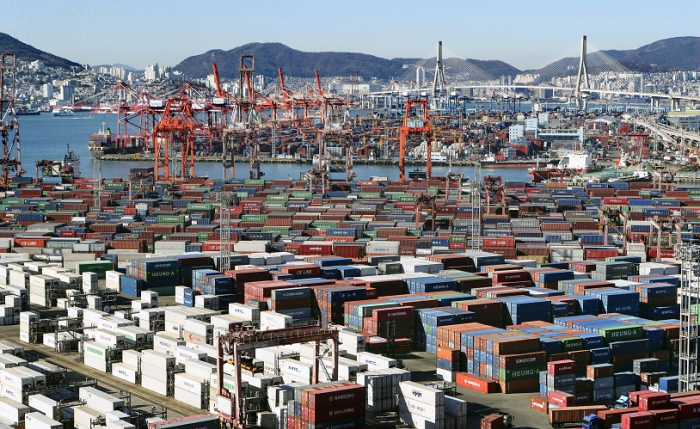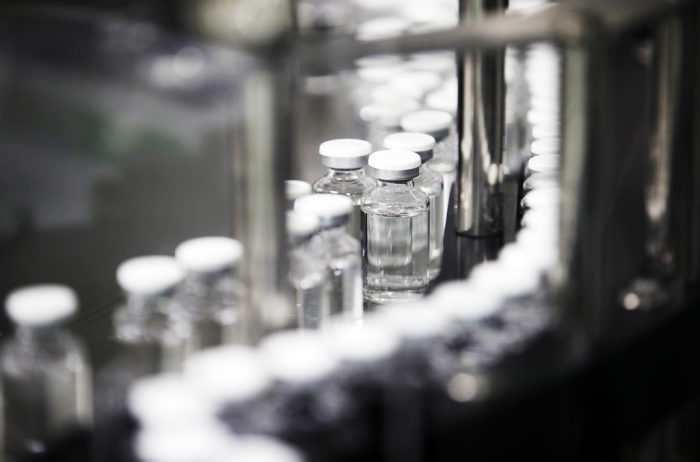Korea exports hit record to top $640 bn in 2021
Semiconductor, automobile, display exports strong; bio, battery, cosmetics surge
By Dec 14, 2021 (Gmt+09:00)
LG Chem to sell water filter business to Glenwood PE for $692 million


KT&G eyes overseas M&A after rejecting activist fund's offer


Kyobo Life poised to buy Japan’s SBI Group-owned savings bank


StockX in merger talks with Naver’s online reseller Kream


Meritz backs half of ex-manager’s $210 mn hedge fund



South Korea’s exports have reached an all-time high thanks to strong overseas demand for key products such as semiconductors amid the global economic recovery. The record indicated domestic companies enhanced competitiveness enough to overcome the global logistics crisis and supply chain disruption.
Exports from Asia’s fourth-largest economy exceeded the previous record of $604.9 billion so far this year as of 11:36 a.m. on Dec. 13 to log the largest since the country started compiling such data in 1956, according to the Korea Customs Service and the Ministry of Trade, Industry and Energy. The ministry predicted exports in 2021 to surpass $640 billion.
“The record exports are a valuable achievement by the public and private sectors that overcame various difficulties such as issues of trade logistics, sustained variants of the virus and supply chain disruptions,” said trade minister Moon Sung-wook in a statement.
South Korea is the world’s seventh-largest exporter with overseas shipments in the first 11 months of 2021 up 26.6% to $583.8 billion from a year earlier.
South Korea exports hit a record high
Unit: billion dollars
※ The 2021 value is a forecast
Source: MOTIE
Graphics by Jerry Lee
The growth came as the global economy has been recovering from the COVID-19 pandemic. The International Monetary Fund (IMF) expected the world’s economy to grow 5.9% this year after contracting 3.1% in 2020. The US and the European Union (EU) were forecast to expand 6% and 5%, respectively, while China was predicted to grow 8%.
STRONG GROWTH IN KEY INDUSTRIES
South Korea benefited more than other countries from the recovery as key domestic industries such as semiconductors and automobiles attracted customers worldwide based on improving competitiveness, the trade ministry and analysts said.
Semiconductor exports totaled $115.2 billion in the first 11 months of the year, accounting for 19.7% of the country’s total overseas sales, near double $62.2 billion in 2016.
South Korea is home to the world’s two largest memory chipmakers – Samsung Electronics Co. and SK Hynix Inc. The nation dominated the global memory chip market with a market share of 58.9% in the first nine months, far higher than 26.3% of the No. 2 US and 7.9% of the No. 3 Japan.
Automobile exports totaled $32.7 billion in the January-September period, allowing South Korea to stay as the world’s No. 5 auto exporters, according to the International Trade Center data cited by the ministry.
That came even as Hyundai Motor Co. and Kia Corp. along with competitors at home and abroad reeled from the automotive chip shortage. The country’s two largest carmakers ramped up sales on high value-added eco-friendly models such as electric vehicles, contributing a rebound in automobile exports this year.
Display exports have been staying around $20 billion for the past decade. South Korea dominated the global organic light-emitting diode (OLED) market with an 83.1% market share in the first nine months. Samsung Display and LG Display Co. accounted for 60.4% and 22.7%, respectively.
The nation exported $11.6 billion worth of solid-state drives (SSDs) in the January-November period, becoming the world’s top SSD producer by market share, compared to an 11th largest maker in 2017.
ADVANCING NEW INDUSTRIES
Overseas sales of emerging industries’ products such as bio and secondary batteries also surged.
Exports of bio, batteries, cosmetics, as well as agricultural products and fisheries, increased by $12.3 billion to a record of $40 billion in the first 11 months of the year from 2018.
Bio products’ outbound shipments nearly doubled to $14.3 billion in January-November from $7.7 billion in the same period in 2018.

Battery exports rose 20% to $7.9 billion, helping the country to rank the world’s No. 2 after China. Consumption of batteries manufactured by South Korea’s three producers – LG Energy Solution Ltd., SK On Co. and Samsung SDI Co. – more than doubled from a year earlier.
The nation became the world’s fifth-largest cosmetics exporter with overseas sales up 46.2% to $8.5 billion in the first 11 months from the same period in 2018.
The export unit value hit a record high on growing exports of high value-added products such as liquefied natural gas (LNG) carriers. South Korea ranked the No. 1 in orders both for LNG carriers and eco-friendly vessels as the Big Three – Korea Shipbuilding & Offshore Engineering Co. (KSOE), Daewoo Shipbuilding & Marine Engineering Co. and Samsung Heavy Industries Co. – won a series of new contracts.
BETTER EXPORT GROWTH
Strong overseas sales by both major conventional and emerging industries helped South Korea’s exports growth outperform the ones of other countries.
Japan’s exports rose 22.6% in the first nine months from a year earlier, while Germany and the US reported growth of 22.1% and 23.3%, respectively, according to available data. They were lower than a 26.2% growth in South Korea’s exports during the period.
Surging exports lifted South Korea to the world’s No. 8 country, the highest rank in nine years, in terms of trade including both exports and imports with its value surpassing $1 trillion won in 299 days this year, the shortest period.
The country reported exports of $100 million first time in 1964. Overseas sales have been steadily increasing since then to top $10 billion in 1977, $100 billion in 1995 and $600 billion in 2018.
Write to Ji-Hoon Lee, Sin-Young Park and Eui-Jin Jeong at lizi@hankyung.com
Jongwoo Cheon edited this article.
-
 Korean chipmakersSamsung, Hynix notch best day this year; metaverse to drive chip demand
Korean chipmakersSamsung, Hynix notch best day this year; metaverse to drive chip demandNov 23, 2021 (Gmt+09:00)
3 Min read -
 Korean chipmakersWinter is over? Samsung's Q3 chip sales beat Intel's
Korean chipmakersWinter is over? Samsung's Q3 chip sales beat Intel'sDec 13, 2021 (Gmt+09:00)
3 Min read -
 Shipping & ShipbuildingKorean shipbuilders win record LNG carrier orders; 2022 outlook bright
Shipping & ShipbuildingKorean shipbuilders win record LNG carrier orders; 2022 outlook brightDec 08, 2021 (Gmt+09:00)
2 Min read -
 EconomyKorea’s November exports top $60 bn for first time to fresh high
EconomyKorea’s November exports top $60 bn for first time to fresh highDec 01, 2021 (Gmt+09:00)
1 Min read -

-
 Shipping & ShipbuildingKorean shipbuilders turn focus to high-value vessels
Shipping & ShipbuildingKorean shipbuilders turn focus to high-value vesselsOct 14, 2021 (Gmt+09:00)
2 Min read


